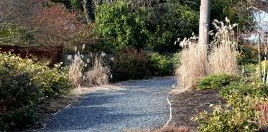Perennial Ornamental Grass
The use of ornamental grasses in gardens and landscaping is growing in popularity all over the country.
Hardy perennial ornamental grass is one of the easiest ways to add structure, texture, and movement to your garden or landscape. Well selected grasses are virtually maintenance free. They are very adaptable and grow well in poor soils. Hardy grasses are extremely resistant to drought, disease, insects and even deer. You don’t have to worry about watering or fertilizing, and the only maintenance some need is a quick cutting back in early spring before the growing season, and a little mulching perhaps to maintain soil moisture and protect in colder regions.
The variety of height, color and texture provides an ornamental grass for nearly every purpose - ground cover, height, erosion control, water garden accents, or specimen plants. Tall grasses add graceful vertical presence to a landscape, both summer and winter. The smaller grasses will do well in containers, and add a striking focal point to a larger pot of annuals. (But remember that even a hardy perennial may not survive winter in a pot.) Ornamental grasses continually change through the year, providing a little different interest element to your garden or landscape in each season. An added bonus is the movement created by gentle breezes, and the soft rustling of the grass in a breeze has a soothing effect. You can also use dried grasses in your indoor floral arrangements for interesting texture and contrast to your cut flowers.
Ornamental grasses may be annual or perennial, and may or may not be winter hardy. So as always in selecting plants, be careful that they are hardy in your growing zone to ensure the easiest care and maintenance. The category of ornamental grasses includes the true grasses, as well as sedges, rushes, even bamboo. Some will do best in hot dry regions, some in the prairie land, some in moist shady regions, and others in cool regions. There are also differences in their “best” season, as you will find cool season grasses that are most striking in spring, and warm season grasses that are best in the height of summer. Most require at least 3 to 6 hours of sunlight to bloom and to reach their peak fall colors. Grasses are also categorized by clump forming or rhizome forming. The clump forming ornamental grasses grow in neat mounds that increase in size over time. The rhizome forming grasses spread by underground rhizomes (stem shoots) that can cause them to be invasive. These are best kept out of your garden and used instead for landscaping difficult areas where a spreading ground cover or screen is desirable.
Ornamental grasses can be planted spring or fall, generally spring is best. If you are planting in a container, that can be done anytime but be sure it gets plenty of water to give it a good start. This generally shouldn’t be a problem as you will be watering to keep other plants in the pot to keep them moist. Soil should not be amended to plant grasses unless you are planting in heavy clay. Some varieties will do fine in clay, which tends to keep the soil more moist, but many prefer dry soil so peat and sand mixed into the planting hole will provide better drainage. Likewise, if you are planting a grass that prefers moist conditions, you should add compost or organic material to sandy soil to help retain moisture. A far better solution is to simply select a grass appropriate for your soil conditions, eliminating extra care for what should be any easy care plant. Mulch grass plant for their first winter season, even a hardy perennial grass will benefit from protection it’s first year.
In spring, just before growth begins, cut the plant back to the ground. Use a hedge shears and wear gloves, some dried grasses can be very sharp. Watering is generally not necessary through the summer, fertilizing should be skipped altogether as long as the plant looks healthy, has good color and is growing well. If not, a light dose of slow release fertilizer in spring will bring the plant back to health. For clump grasses, dividing clumps that are too large may be the only difficult maintenance required. The root masses are dense and difficult to divide. If you prefer your grass maintain a smaller clump size you may not want to let the clump size get too out of control before dividing, perhaps every 3 or 4 years. Dig up the whole clump in spring, cut it in pieces, and plant or discard the extras. See dividing tough perennial instructions for help, and if necessary, just use an axe - not kidding.
